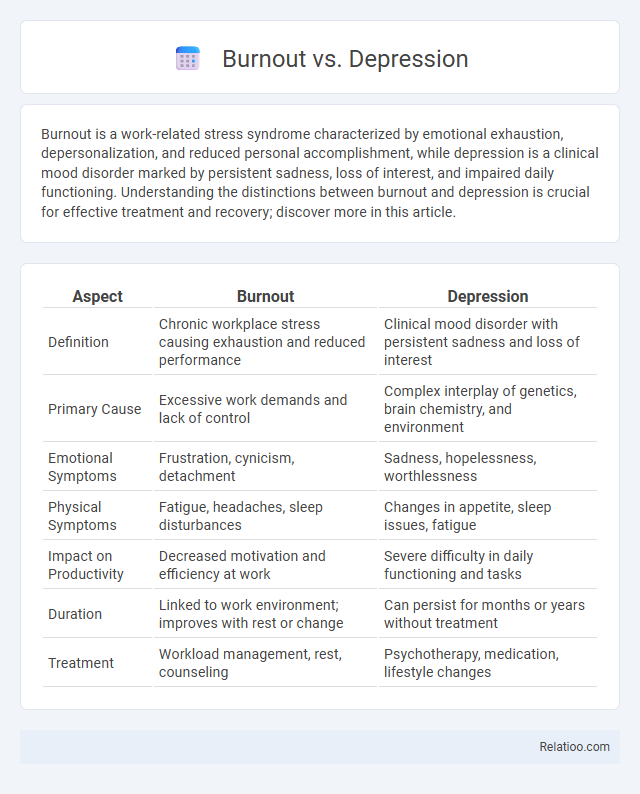Burnout is a work-related stress syndrome characterized by emotional exhaustion, depersonalization, and reduced personal accomplishment, while depression is a clinical mood disorder marked by persistent sadness, loss of interest, and impaired daily functioning. Understanding the distinctions between burnout and depression is crucial for effective treatment and recovery; discover more in this article.
Table of Comparison
| Aspect | Burnout | Depression |
|---|---|---|
| Definition | Chronic workplace stress causing exhaustion and reduced performance | Clinical mood disorder with persistent sadness and loss of interest |
| Primary Cause | Excessive work demands and lack of control | Complex interplay of genetics, brain chemistry, and environment |
| Emotional Symptoms | Frustration, cynicism, detachment | Sadness, hopelessness, worthlessness |
| Physical Symptoms | Fatigue, headaches, sleep disturbances | Changes in appetite, sleep issues, fatigue |
| Impact on Productivity | Decreased motivation and efficiency at work | Severe difficulty in daily functioning and tasks |
| Duration | Linked to work environment; improves with rest or change | Can persist for months or years without treatment |
| Treatment | Workload management, rest, counseling | Psychotherapy, medication, lifestyle changes |
Understanding Burnout and Depression: Key Differences
Burnout primarily results from chronic workplace stress characterized by emotional exhaustion, cynicism, and reduced professional efficacy, while depression is a broader mental health disorder marked by persistent sadness, loss of interest, and impaired daily functioning. Understanding the key differences lies in recognizing burnout's connection to external job-related factors versus depression's internal psychological nature, which may affect various life domains beyond work. Your ability to identify these distinctions is crucial for seeking targeted interventions and effective treatment strategies.
Defining Burnout: Causes and Symptoms
Burnout is a state of physical, emotional, and mental exhaustion caused by prolonged stress, often related to work or caregiving responsibilities. Key symptoms include chronic fatigue, feelings of cynicism or detachment from tasks, and decreased performance, differentiating it from clinical depression which involves pervasive low mood and hopelessness. Understanding the causes of burnout, such as excessive workload, lack of control, and insufficient support, can help you recognize and address it before it impacts overall mental health.
What is Depression? Clinical Features Explained
Depression is a clinical mood disorder characterized by persistent feelings of sadness, hopelessness, and a loss of interest in activities once enjoyed. Key clinical features include significant changes in appetite or weight, sleep disturbances, fatigue, impaired concentration, and recurrent thoughts of death or suicide. Unlike burnout, which is primarily work-related and situational, depression affects multiple aspects of life and often requires comprehensive treatment including psychotherapy and medication.
Overlapping Signs: Burnout Versus Depression
Burnout and depression share overlapping signs such as chronic fatigue, irritability, and difficulty concentrating, which can make distinguishing between the two challenging. You may experience emotional exhaustion and feelings of detachment in both conditions, but burnout is typically work-related and improves with rest, while depression affects multiple areas of life and often requires professional treatment. Recognizing these shared symptoms early can guide your approach to effective management and recovery.
Diagnostic Criteria: How Professionals Differentiate
Diagnostic criteria for burnout primarily focus on emotional exhaustion, depersonalization, and reduced personal accomplishment, as outlined in the Maslach Burnout Inventory. Depression is diagnosed based on DSM-5 criteria including persistent sadness, anhedonia, significant weight change, sleep disturbances, and impaired functioning for at least two weeks. Clinicians differentiate burnout from depression by evaluating symptom duration, scope, and presence of core depressive signs, with burnout often confined to occupational contexts and depression affecting multiple life areas.
Risk Factors for Burnout and Depression
Burnout and depression share overlapping symptoms but stem from different risk factors; burnout primarily arises from chronic workplace stress, excessive job demands, and lack of control, while depression is influenced by genetic predisposition, biochemical imbalances, and traumatic life events. Your exposure to prolonged stress without adequate coping mechanisms increases the risk of burnout, whereas depression risk escalates with factors such as family history, social isolation, and significant loss. Understanding these risk factors is crucial for early identification and effective intervention.
Impact on Daily Life: Functional Differences
Burnout primarily affects work performance and motivation, leading to exhaustion, cynicism, and reduced efficacy in professional tasks, while depression encompasses broader symptoms like persistent sadness, loss of interest, and impaired functioning across all areas of daily life. Individuals experiencing burnout may still manage personal relationships and self-care but struggle with job-related responsibilities, whereas depression often disrupts social interactions, physical health, and cognitive abilities beyond the workplace. Understanding these functional differences is crucial for accurate diagnosis and tailored treatment strategies.
Approaches to Treatment and Intervention
Effective treatment approaches for burnout primarily involve stress management techniques, cognitive-behavioral therapy (CBT), and organizational changes to reduce workload and improve work-life balance. Depression treatment often requires a combination of antidepressant medication, psychotherapy, and lifestyle modifications tailored to individual patient needs. While burnout recovery emphasizes restoring energy and motivation through rest and behavioral adjustments, depression interventions focus on addressing underlying mood disorders and cognitive distortions with professional mental health support.
Preventive Measures and Self-Care Strategies
Preventive measures for burnout focus on managing workload, setting realistic goals, and prioritizing regular breaks to maintain mental and physical resilience. Self-care strategies for depression emphasize consistent therapy, medication adherence when prescribed, and fostering social support networks to enhance emotional stability. Combining stress management techniques with healthy lifestyle choices such as adequate sleep, balanced nutrition, and physical activity effectively mitigates symptoms in both burnout and depression conditions.
Seeking Help: When to Consult a Professional
Recognizing the differences between burnout, depression, and chronic stress is crucial for seeking timely professional help to protect your mental health. You should consult a mental health professional if symptoms such as persistent sadness, overwhelming fatigue, loss of interest, or impaired functioning continue beyond a short period or worsen despite self-care efforts. Early intervention through therapy, counseling, or medical treatment can effectively address these conditions and improve your overall well-being.

Infographic: Burnout vs Depression
 relatioo.com
relatioo.com